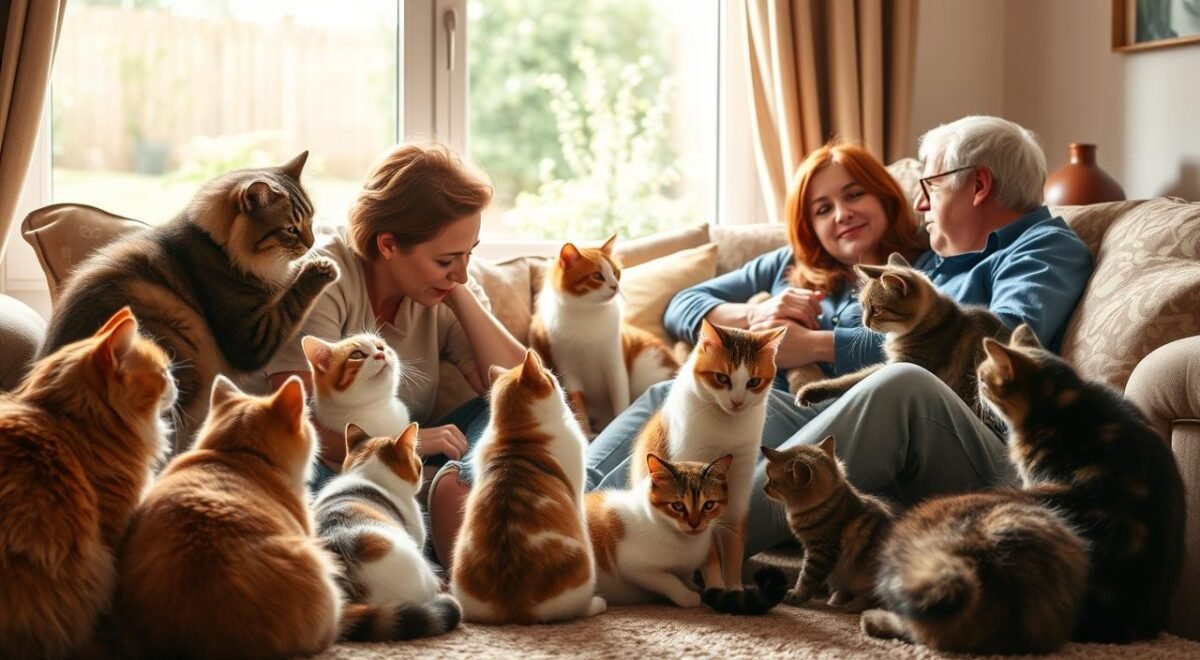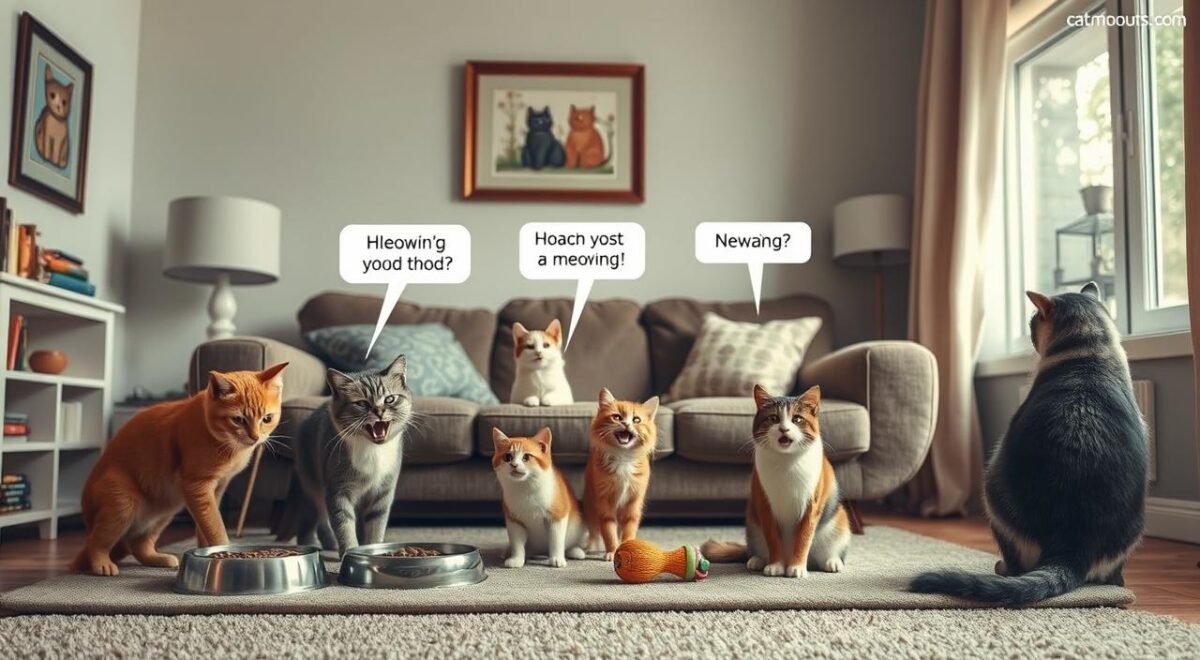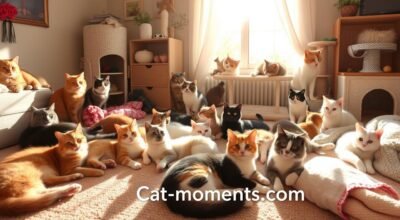Cats are known for their unique sounds, especially meowing. They mostly use body language and other sounds to talk to each other. But meowing is special for when they talk to humans. Knowing why cats meow helps us understand their needs, feelings, and health better. This makes our bond with them stronger.
Key Takeaways
- Cats use meows to convey various needs, emotions, and physical requirements to their human companions.
- Certain cat breeds, such as Siamese and Abyssinians, are naturally more vocal than others.
- Increased vocalization in older cats may indicate underlying health issues, prompting a visit to the veterinarian.
- Kittens who are well-socialized and handled frequently may become more vocal as adults.
- Cats may meow to seek reassurance when feeling anxious or confused, or to communicate specific desires like attention, food, or companionship.
The Evolution of Cat Communication with Humans
The bond between cats and humans has grown over thousands of years. This is seen in how they talk to each other. Domestic cats have made their sounds more appealing to humans.
For over 5,000 years, cats and humans have lived together. Cats have learned to use meows to talk to their human friends. Adult cats usually don’t meow to each other, but they do with humans.
A study looked at 100 cat sounds from 12 cats. These sounds were played for 26 people, who rated them for how nice they sounded. Another 28 people judged how urgent the sounds were. The study found that nice-sounding meows were short and even in sound, while urgent ones were long and had more low sound.
This study showed how cats have changed their meows to please humans. Unlike their wild ancestors, domestic cats now make sounds that humans find pleasant. This helps them get what they want from their owners.

“Cats use vocal communication more with humans due to domestication, as they rarely meow at each other. Cats communicate through their sense of smell or by rubbing against objects in their natural state. Humans do not possess the same sense of smell as cats, making vocal communication more effective for cats when interacting with humans.”
Cats have adapted to live with humans in a remarkable way. By learning to meow to humans, they’ve built a strong connection. This bond has grown over thousands of years of living together.
Why Do Cats Meow?
Cats meow for many reasons, like basic communication, emotional needs, and physical needs. Knowing the different types of meows helps us understand our cats better.
Basic Communication Needs
Cats meow to greet people or to get attention. They might meow when they see family members or when someone comes home. They also meow to ask for food, play, or to be social.
Emotional Expression
Cats show many emotions through their meows, from happiness to anxiety or frustration. A soft meow can mean they’re happy, while a loud meow might mean they’re upset or need something.
Physical Requirements
- Cats meow to tell us about their physical needs, like hunger, thirst, or feeling uncomfortable.
- Meowing too much can also mean they have a health issue, like an overactive thyroid or kidney disease. It’s important to see a vet.
- Teaching cats to be quiet for attention and regular feeding times can help reduce meowing.
The way a cat meows tells us a lot about what they need or how they’re feeling. By understanding their meows, we can meet their communication needs better.

Different Types of Cat Vocalizations
Cats make many sounds beyond just meowing. These sounds help them talk to humans and other cats. Knowing what these sounds mean can tell you how your cat is feeling and what they need.
Purring shows a cat is happy and relaxed. Cats might chirp or trill to get someone’s attention. These sounds are different from meows, which adult cats use to talk to people.
Hissing means a cat feels scared and might defend itself. Yowls are long sounds that show discomfort or territorial issues. Female cats in heat make a caterwaul to attract mates.
Snarls and growls are aggressive sounds that show fear or anger. Shorthaired cats are often more talkative than longhaired ones. Cats from Asia are known for being very chatty.
Watching how often and in what patterns your cat meows can tell you a lot. By knowing the different cat noises, you can better understand your cat’s types of cat meows and feline vocal sounds.
| Vocalization Type | Percentage of Total Cat Vocalizations | Meaning and Purpose |
|---|---|---|
| Murmuring (Purrs, Trills) | 44% | Indicates contentment and positive emotional state |
| Vowel Patterns (Meows) | 35% | Primary method of communication with humans |
| Articulated Patterns (Chirps, Chattering) | 12% | Convey frustration or to get attention |
| Strained Intensity (Hisses, Growls) | 9% | Indicate fear, aggression, or territorial threats |
Most cats (95%) meow mainly to talk to humans, not other cats. Knowing the different cat noises helps you understand your cat’s types of cat meows and feline vocal sounds.
Understanding Your Cat’s Meowing Patterns
Learning to understand your cat’s meows is key to a stronger bond. Cats use different sounds to tell us what they need or how they feel. From soft purrs to loud meows, each sound has its own message.
Morning Meows
In the morning, cats often meow a lot. These early sounds can mean they’re hungry or want to play. Knowing what these meows mean helps us meet their needs and start the day right.
Attention-Seeking Vocalizations
Cats know how to get our attention with their meows. Whether it’s a soft or loud meow, they’re asking for love, play, or a favorite spot. By listening and responding, we can grow closer to our cats.
Distress Calls
But sometimes, cats make loud, long calls when they’re in pain or uncomfortable. These calls mean they need help or are in a bad situation. Hearing and acting on these calls quickly can make our cats feel better.
Understanding your cat’s meows helps you be a better pet owner. It lets you meet their needs and build a stronger connection. Learning about cat meows is important for a happy cat-human relationship.
| Type of Meow | Meaning | Appropriate Response |
|---|---|---|
| Morning Meows | Hunger or desire for attention | Feed the cat or engage in play |
| Attention-Seeking Vocalizations | Request for affection, playtime, or access to a preferred spot | Provide the desired attention or access |
| Distress Calls | Indicate pain, discomfort, or a cat being stuck in an undesirable situation | Promptly address the cat’s concerns and ensure their well-being |
“Understanding a cat’s meows can strengthen the bond between the owner and the feline companion.”
By knowing and responding to different meows, we can understand our cats better. This helps us meet their needs and makes our relationship with them better.
Body Language and Vocal Communication
Cats are experts at talking without words. They use cat body language and sounds to share their feelings and needs. It’s not just the meow that matters. Their non-verbal cues tell us a lot about what they’re thinking and feeling.
Tail positions are very telling. A high tail shows confidence. But a tucked or swishing tail might mean fear, anger, or a sudden urge to jump. Ear movements also tell a story. Relaxed ears show happiness, while flattened ears might mean they’re upset or scared.
- Facial expressions, like a lip curl showing teeth, can mean fear or anger.
- Pupil size can show excitement, fear, or pain. It’s important to notice these small cat body language signs.
Knowing how to read feline non-verbal communication helps us understand our cats better. It lets us meet their needs and solve any problems they might have. Regular vet visits and talking to your vet are key to keeping your cat healthy and happy.
| Cat Body Language Cue | Meaning |
|---|---|
| Tail held high | Confidence |
| Tucked or swishing tail | Fear, aggression, or readiness to pounce |
| Relaxed ears | Contentment |
| Flattened ears | Anger or distress |
| Lip curl revealing teeth | Fear or aggression |
| Dilated pupils | Excitement, fear, or pain |
“By observing and understanding cat body language, we can gain valuable insights into our feline companions’ emotional states and needs, strengthening the bond between cats and their human caregivers.”
Age-Related Changes in Cat Vocalizations
Cats change how they make sounds as they get older. Kittens use high-pitched mews to talk to their moms. Adult cats meow in ways that show their personality and where they live.
Kitten Communications
Newborn kittens use their voices to stay close to their moms. They make sounds like mews, squeaks, and cries. These sounds help them get food, warmth, and comfort.
Adult Cat Meowing Patterns
As cats grow up, their meows become more unique. They might meow to get attention, show feelings, or ask for something. Some breeds, like Siamese and Tonkinese, are very talkative with their owners.
Senior Cat Vocalizations
Older cats may meow more because of health issues like Cognitive Dysfunction Syndrome (CDS). They might get confused, restless at night, or have trouble using the litter box. This can lead to more meowing and yowling.
Knowing how cats change their sounds as they age helps owners understand them better. It’s important to notice these changes. It can help spot health or behavior problems early, making life better for older cats.
| Lifespan Stage | Vocalization Characteristics | Potential Implications |
|---|---|---|
| Kitten | High-pitched mews, squeaks, and cries | Essential for communication with mothers and survival |
| Adult | Individualized meowing patterns, breed-specific vocal tendencies | Expressing emotions, seeking attention, and communicating needs |
| Senior | Increased vocalization, yowling, disorientation-related sounds | Indicators of cognitive decline, sensory deterioration, or health concerns |
“Understanding the age-related changes in cat vocalizations can help pet owners better interpret their feline’s needs and adapt their care accordingly.”
Health and Behavioral Issues Related to Meowing
Excessive or unusual meowing in cats can signal health or behavioral problems. It might mean pain, hunger, thirst, or even cognitive issues in older cats. If a cat’s meowing changes suddenly, it’s time to see the vet. They can check for issues like hyperthyroidism, kidney disease, or infections.
Changes in the home, losing a loved one, or getting a new pet or baby can stress cats. Some breeds, like Siamese and Bengals, are naturally more talkative. Finding and fixing the cause of meowing is key to keeping your cat happy and your bond strong.
Scolding or spraying a cat with water doesn’t work and can make things worse. Instead, use positive reinforcement and patience. This approach can help reduce meowing. Understanding why your cat meows and giving them the right care can improve your relationship.
FAQ
Why do cats meow?
Cats meow to talk to humans. They learned to use meows to get what they need from us. It’s a way for them to share their feelings and needs.
How do cats communicate with humans?
Cats meow to talk to us because they can’t show us their feelings with body language. They learned to meow to get our attention and to tell us what they need.
What are the different reasons cats meow?
Cats meow for many reasons. They meow to say hello, to ask for attention, or to tell us they’re hungry or thirsty. They also meow when they’re feeling happy or scared.
What other types of vocalizations do cats make?
Cats make many sounds. They purr when they’re happy, chirp to say hello, and yowl when they’re upset. They growl when they’re scared or mad, and chatter when they see prey.
How can I understand my cat’s meowing patterns?
Morning meows mean they’re hungry or want attention. They meow for playtime or pets. Loud, drawn-out meows mean they’re in pain or stuck.
How do cats use body language and vocalizations together?
Cats use body language and meows to talk. They show their mood with their tail, ears, and face. Knowing both helps us understand what they’re trying to say.
How do cat vocalizations change over a cat’s lifespan?
Kittens meow to their mom. Adult cats have their own meow style. Senior cats may meow more because of age.
When should I be concerned about excessive or unusual meowing in my cat?
Too much meowing can mean they’re sick or need attention. It could be hunger, thirst, or age-related issues. If their meowing changes suddenly, see a vet.
Source Links
- https://www.humanesociety.org/resources/understanding-feline-language
- https://catbehavioralliance.com/cat-behaviors/cat-communication/the-cat-meow/?srsltid=AfmBOorutahOdq1hp7KrCeSPubjjRu8YKJtWhI8cLchOGLwgwORq2Pvd
- https://news.cornell.edu/stories/2002/05/meow-isnt-language-enough-manage-humans
- https://www.livescience.com/why-cats-meow.html
- https://conservationcubclub.com/the-evolution-of-the-house-cats-manipulative-meow/
- https://www.aspca.org/pet-care/cat-care/common-cat-behavior-issues/meowing-and-yowling
- https://catbehavioralliance.com/cat-behaviors/cat-communication/the-cat-meow/?srsltid=AfmBOooKLozxv2EC81s1SOmi_xTwObtOYCB6tbExDIh0TZkZ0xsaYA09
- https://moderncat.com/articles/12-sounds-cats-make-and-what-they-mean/
- https://www.thesprucepets.com/cat-talk-meowing-554066
- https://www.purina.com.au/cat-meow-meaning.html
- https://nationalkitty.com/what-do-different-meows-mean/
- https://catbehavioralliance.com/cat-behaviors/cat-communication/the-cat-meow/?srsltid=AfmBOooxS3fW5PMdWtaLjCKDKzNp6V2JMkaeuG8TuXPToynyELz4poTA
- https://www.eastvalleyanimal.com/closer-look-at-cat-communication/
- https://www.aspca.org/pet-care/cat-care/common-cat-behavior-issues/older-cats-behavior-problems
- https://www.petplan.co.uk/pet-information/cat/advice/older-cat-language/
- https://www.webmd.com/pets/cats/cats-excessive-meowing
- https://www.petmd.com/cat/behavior/cat-meowing
- https://allaboutcatsonline.com/blog/274697-cat-behavior-issues-meowing-and-yowling_2






